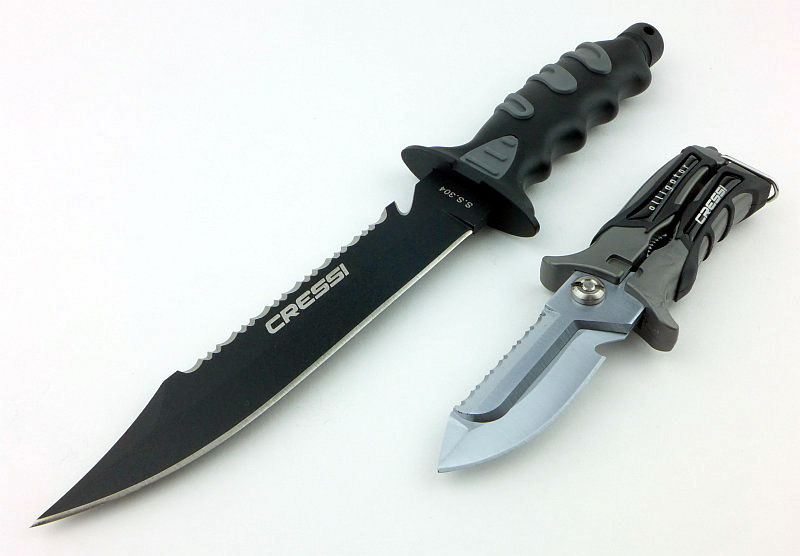This review provides further details for the Cressi Giant Knife and Alligator which could not be included in the Dive Knives 2016 – Mega Test Review
The candidates sent by Cressi were a last minute addition to the Mega Test Review, so unfortunately did not go on the Ionian Sea trip and missed out on some of the real use testing, however they did go through all of the experimental corrosion and cutting testing.
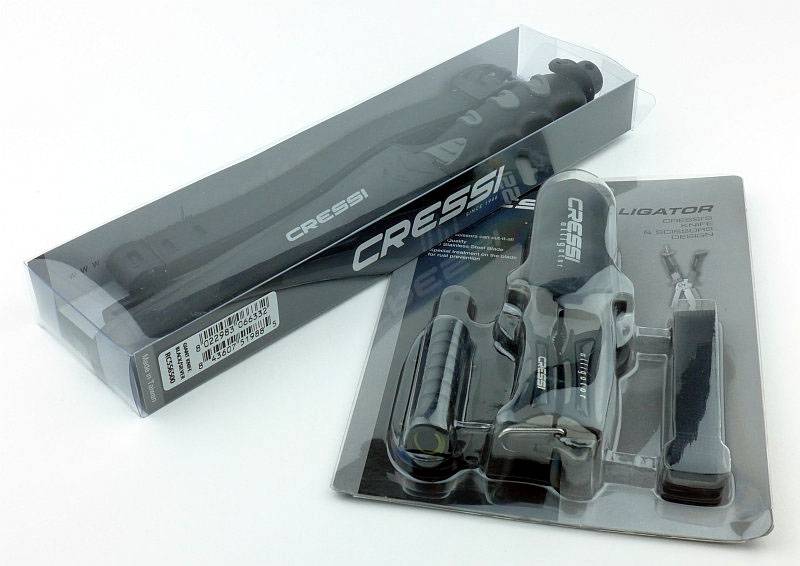
A pretty unique pair from Cressi with a knife at at each end of the size spectrum.
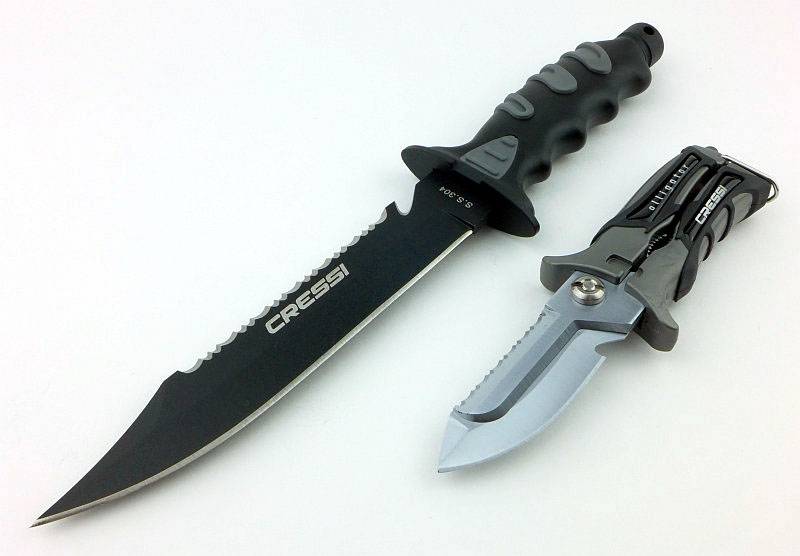
The Blade and Handle Geometry:
Most knife specifications have a basic description of the blade geometry, but in this section I will be taking a more detailed look at geometry and balance.
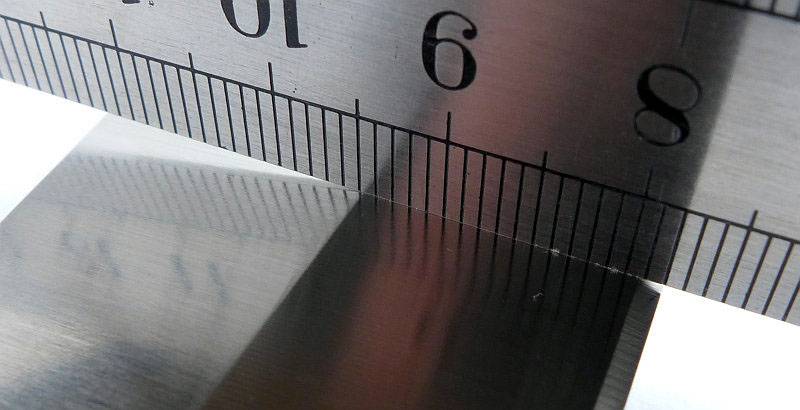
Using a set of gauges and precision measuring equipment including a Vernier protractor, callipers, fixed radius gauges and the unique Arc Master adjustable radius gauge (the one that looks like a crossbow).
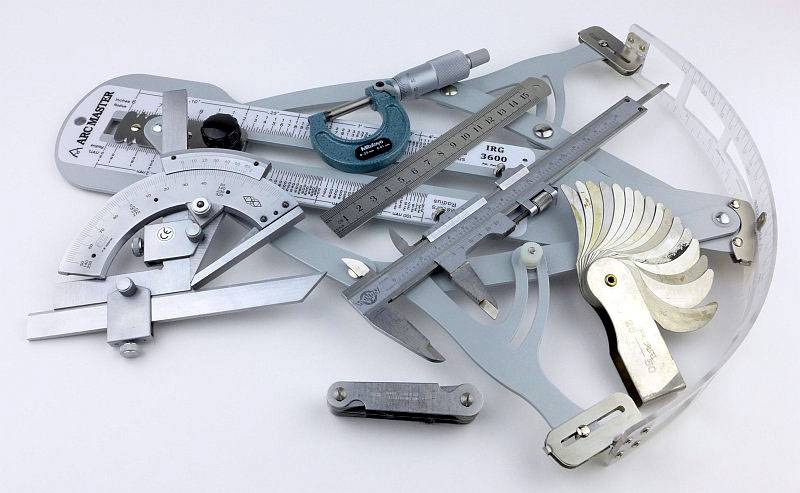
These measurements have been tabulated and are presented along with other blades.
Key aspects such as the primary bevel angle, grind type, blade depth, blade thickness, length, weight are detailed, along with balance information.
The ‘Balance relative to the front of the handle’ tells you if the knife will feel front heavy, or if the weight is in your hand (a positive value means the weight is forward of the front of the handle). The ‘Balance relative to the centre of the handle’ indicates how close to a ‘neutral balance’ the knife has in the hand.
In the case of full convex grinds the approximate centre of the grind is used for the primary bevel angle estimate.
The measurements are presented alongside some of the other knives from the Dive Knives 2016 – Mega Test Review
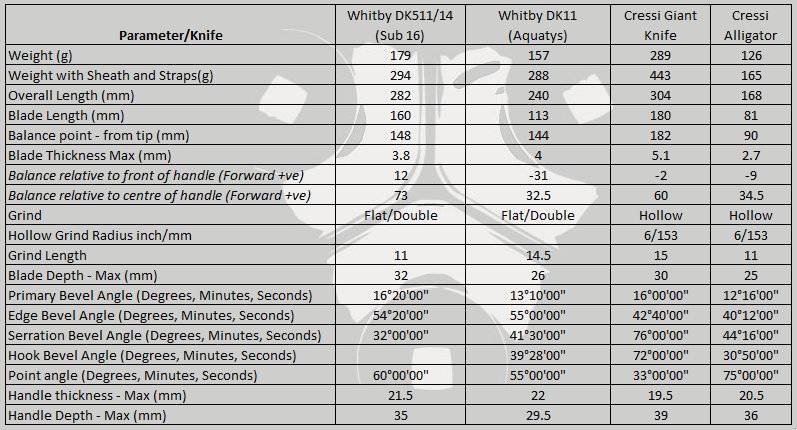
A few more details of the Giant Knife:
Very nicely presented in its transparent box, the Giant Knife is clearly exactly what it says it is.
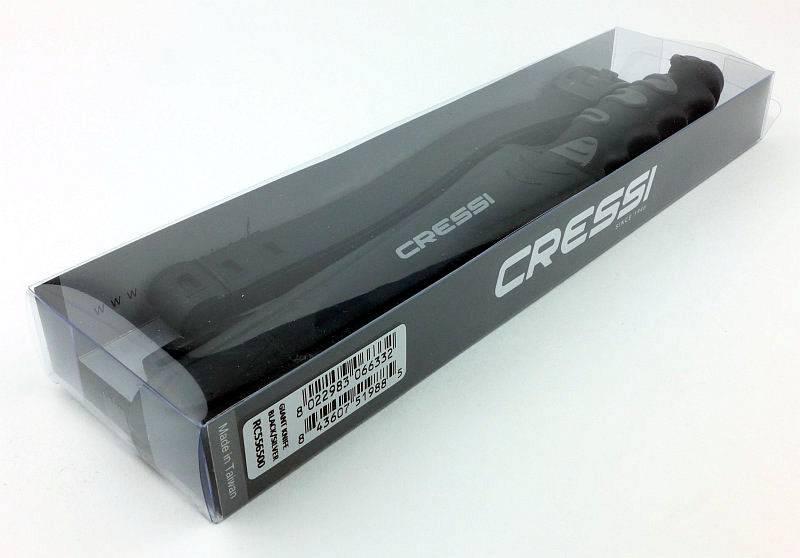
The knife and sheath come with a pair of rubber straps.
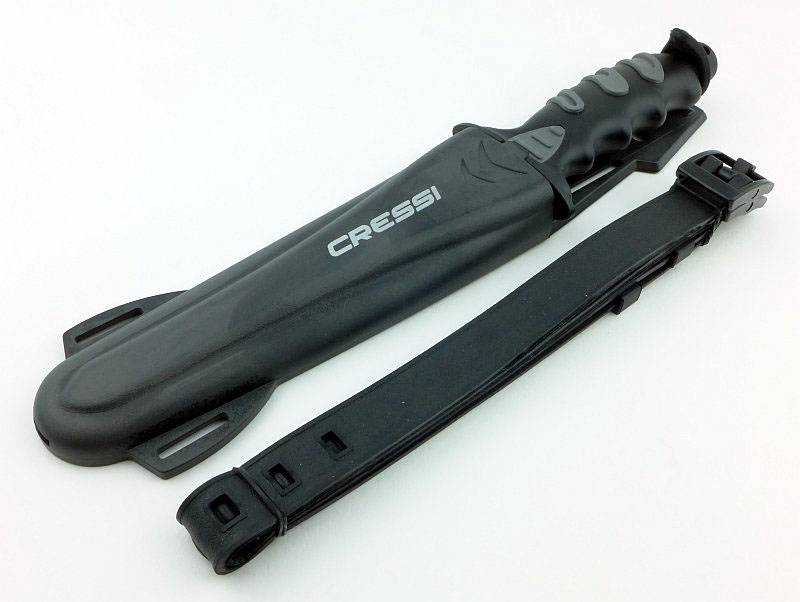
Standard belt buckle type straps are used.
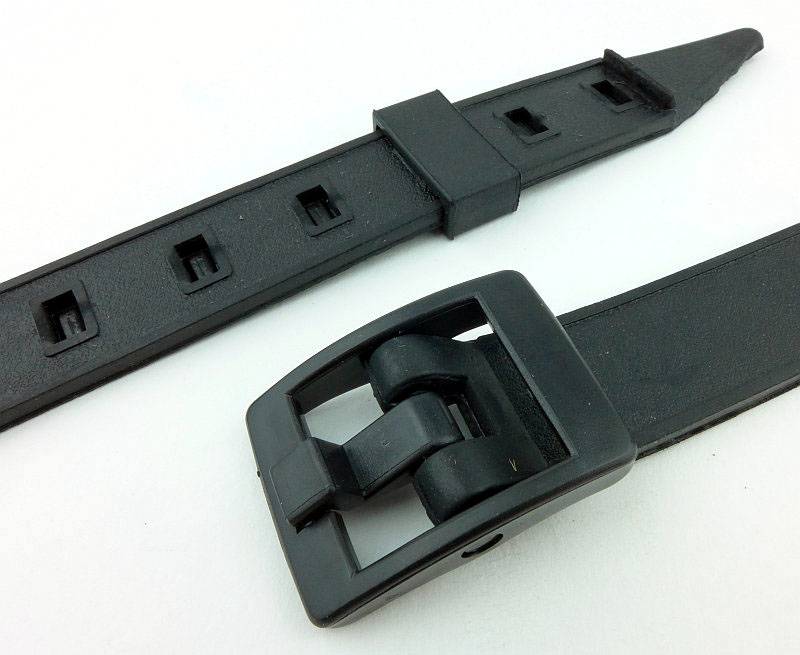
The back of the sheath is basically flat.
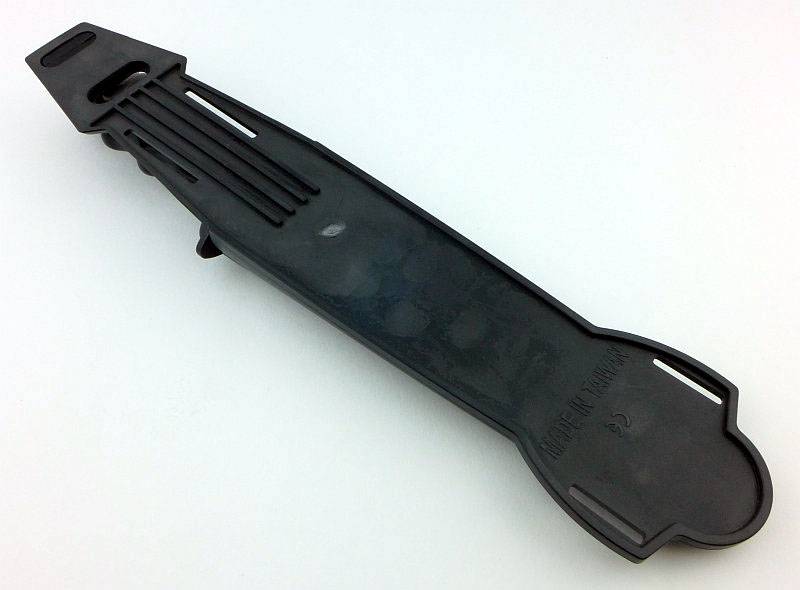
One set of strap mounting points and what looks like an upside-down “CE” mark.
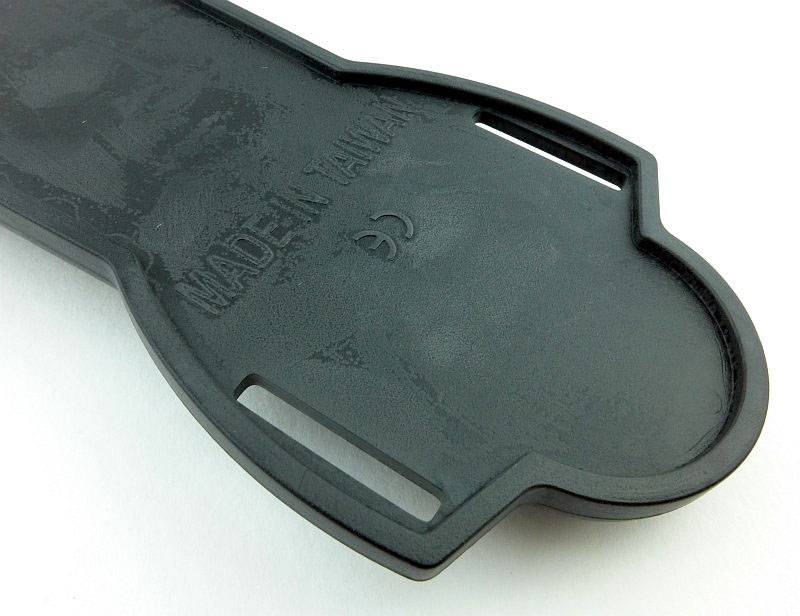
Near the top of the sheath are the other set of strap mounting holes. Something that has me curious is that the rubber retaining ring fits into a hole right at the top of the sheath, but there is an identical hole slightly further down. This could not be used for the retaining ring as you would never get it to fit over the handle, so is there another knife that uses this same sheath?
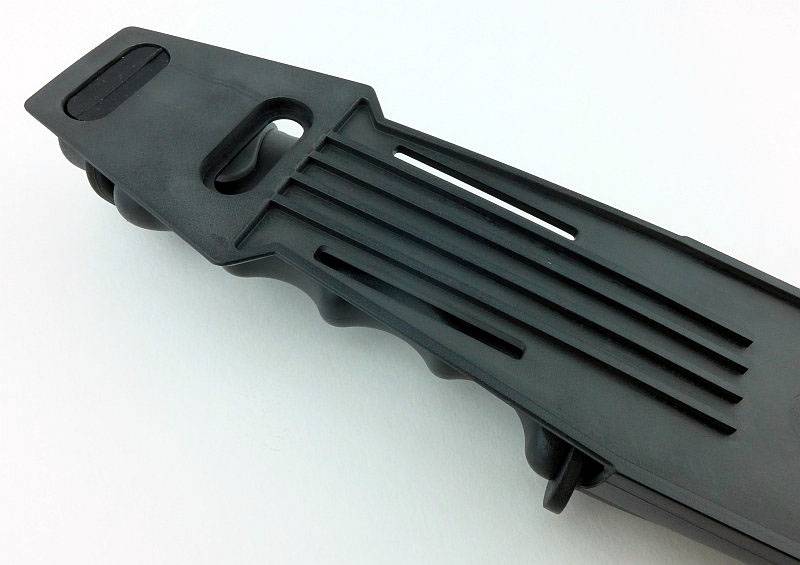
Staying with the old-school concept, the Giant Knife has a rubber retaining ring which is pulled over the hammer pommel.
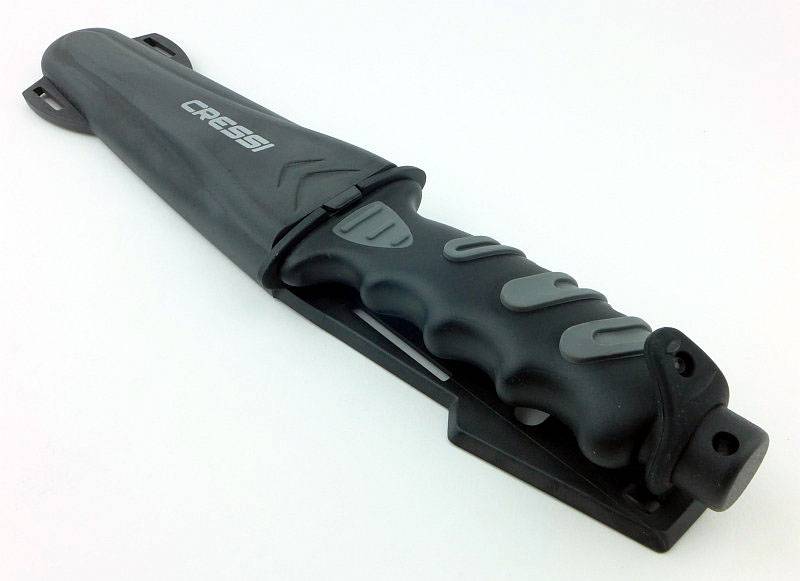
Very neatly put together, the rubber ring has a tab which is easy to grip.
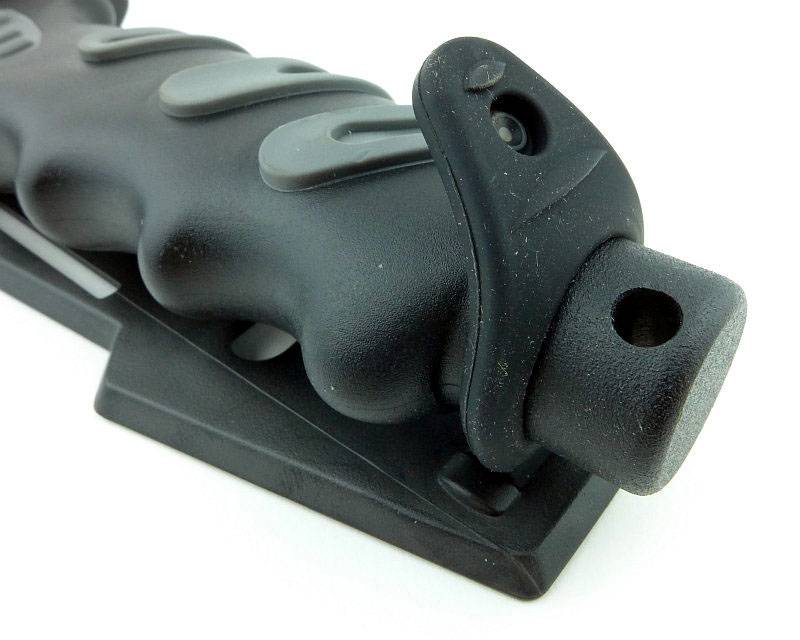
In the released position the rubber ring is pushed out of the way. Like this the knife is just loose in the sheath and can fall out.
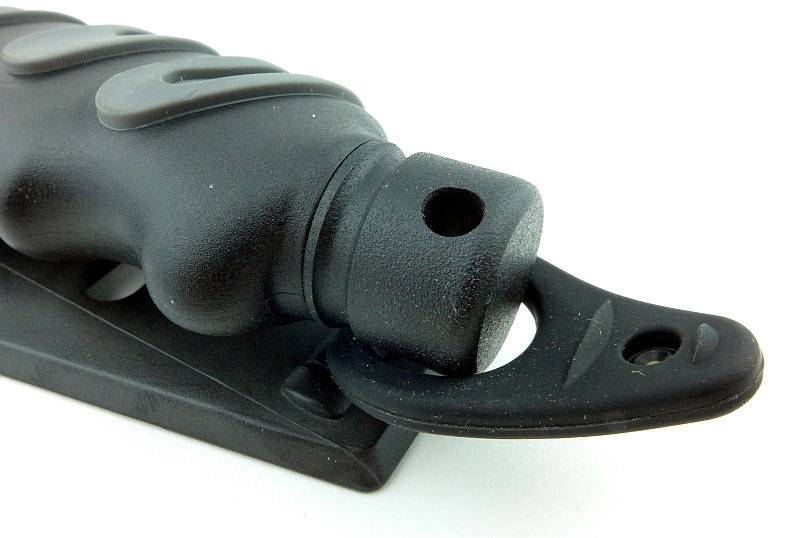
The sheath is a one piece moulded plastic design.
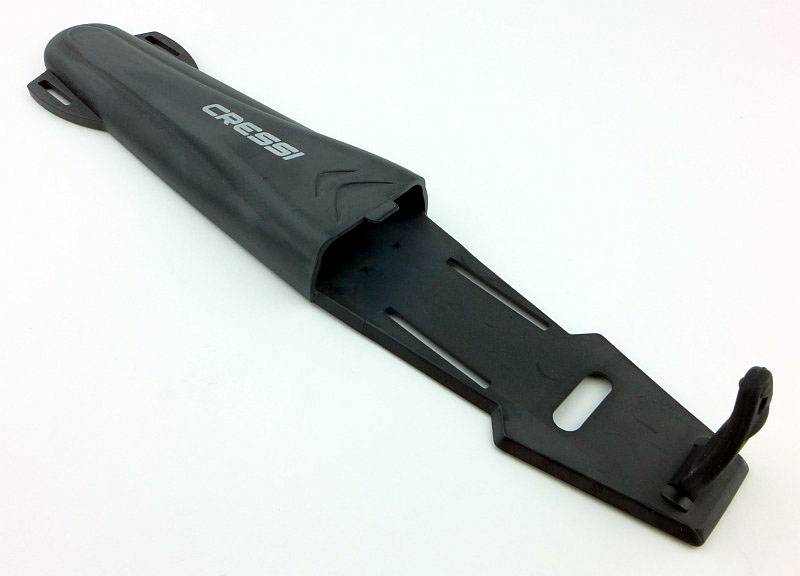
And there is that substantial blade. Perhaps not actually ‘giant’, but this is certainly a BFK.
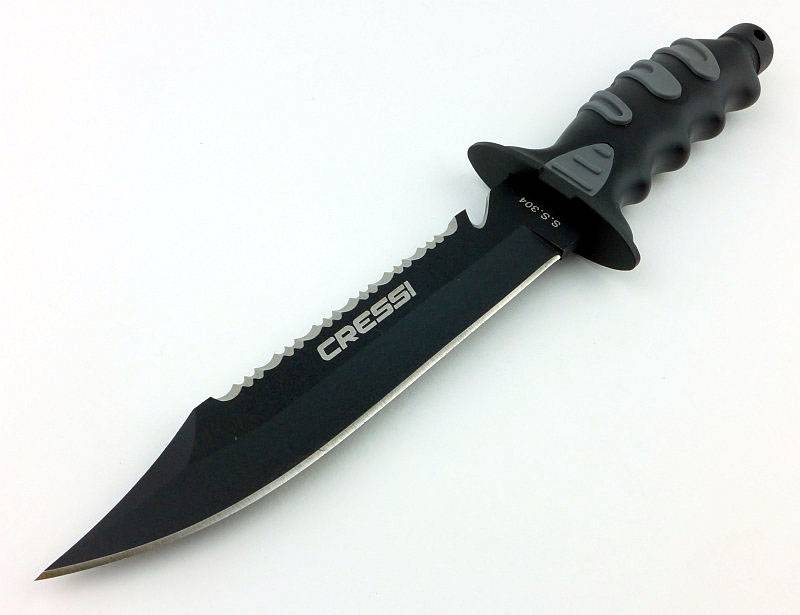
As we all know, ‘stainless’ really means ‘stain-resistant’ and Cressi have given the blade a black coating which helps with corrosion resistance, though the cutting edge itself cannot be coated.
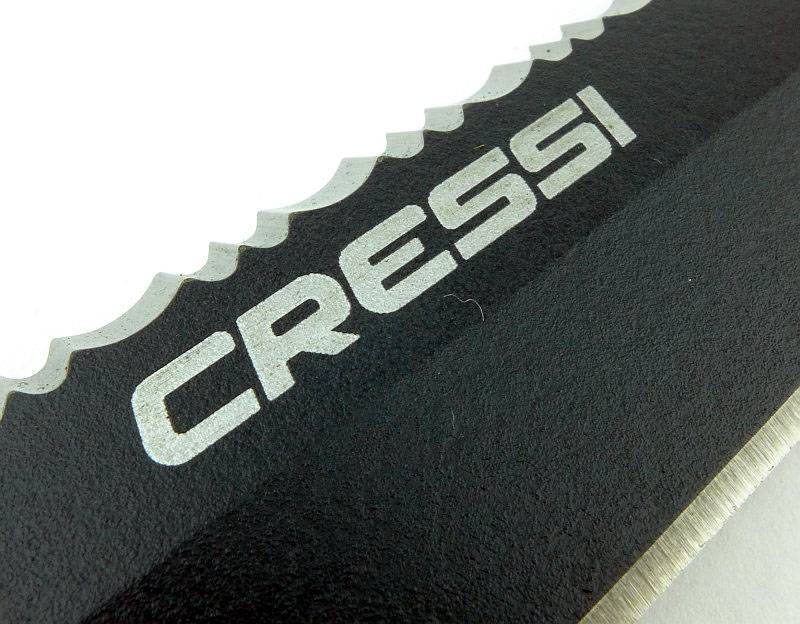
Clearly marked as being made from 304 Stainless Steel.
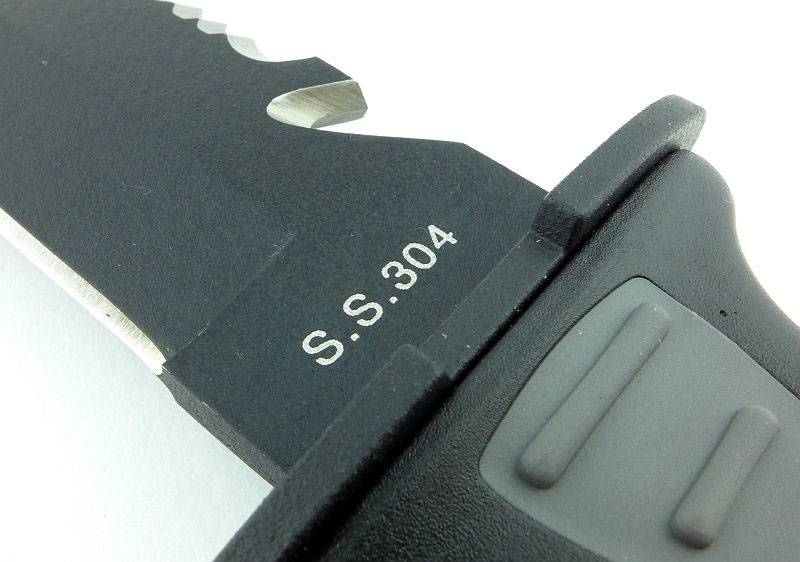
Incorporated into the blade spine is a line cutting hook. This angle clearly shows how wide the double bevel angle is (also see the parameter table) which unfortunately makes it very ineffective.
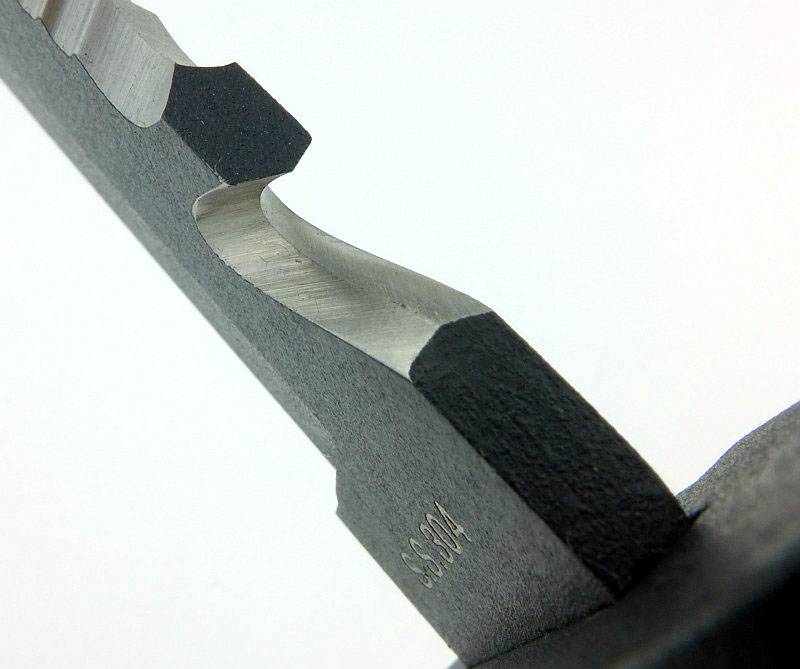
The back of the blade also has a long line of serrations which unfortunately are also a double bevel with a very wide angle which limits their effectiveness.
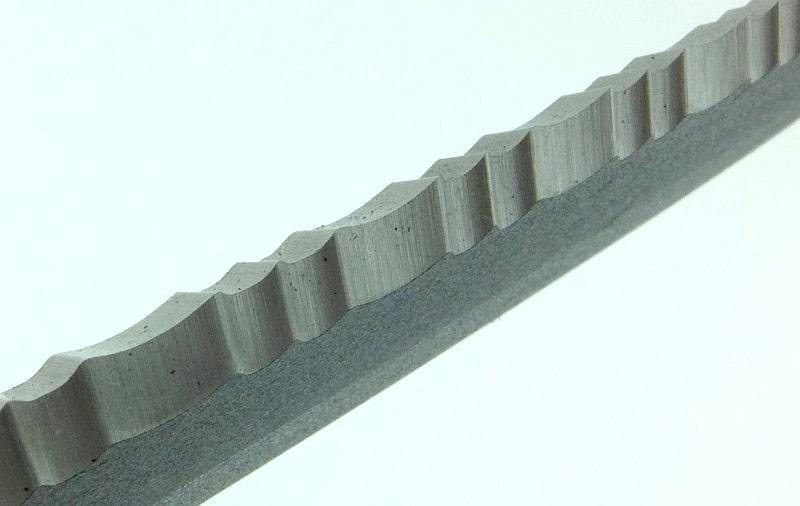
A view of the ricasso and plunge line.
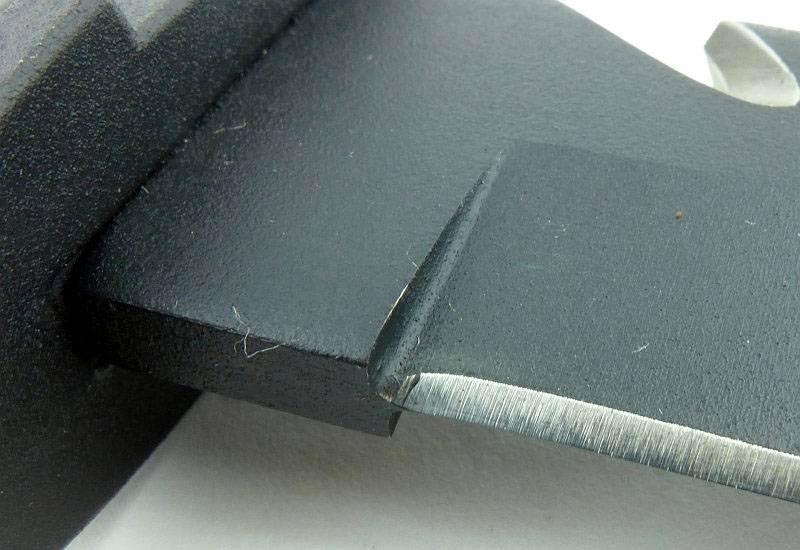
Being a true dive knife, the Giant Knife can be taken apart to clean and maintain the knife. The steel hammer pommel unscrews.
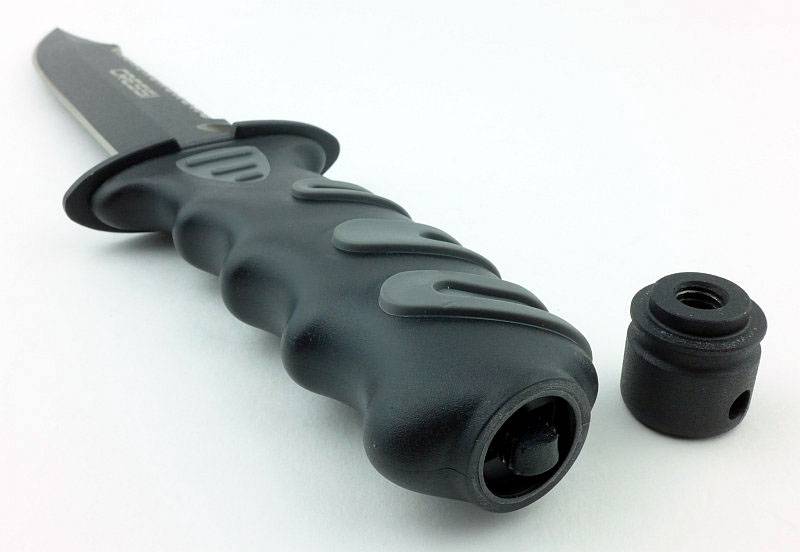
After taking off the pommel, the handle slides off the tang. The full tang has been given the same black coating as the blade, so reduces the need to disassemble and clean it.
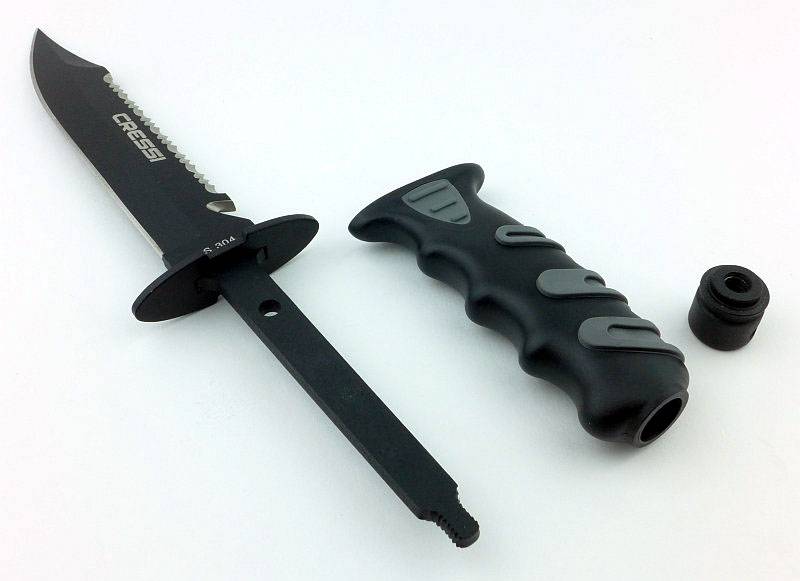
Even the thread is coated, but given a few disassemblies this will wear off.
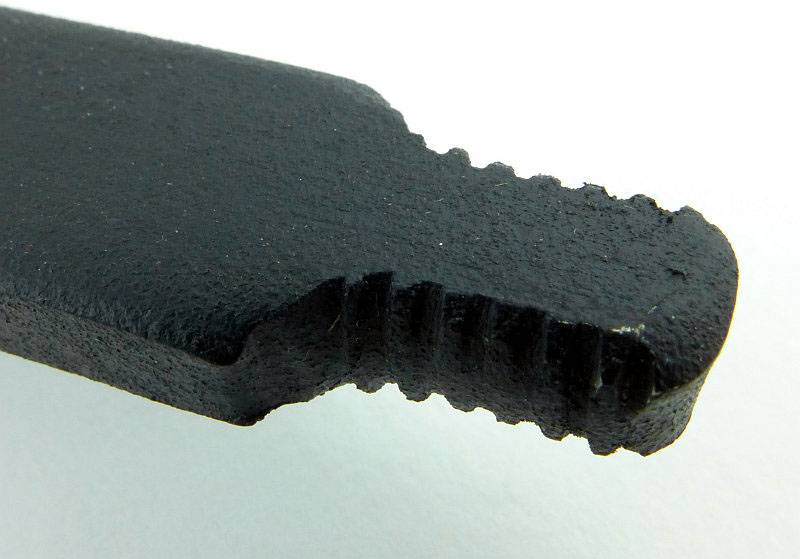
A few more details of the Alligator:
Switching to a completely different concept to the Giant Knife, we have the Alligator.
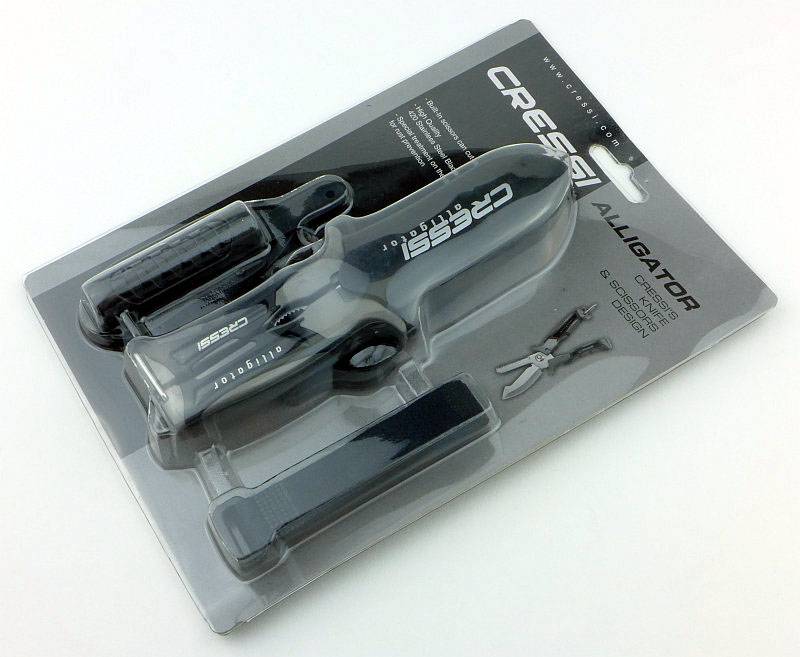
Being a much smaller knife, this is designed to be fitted to your BCD or belt and not to your arm or leg, so instead of rubber straps you get a mounting kit.
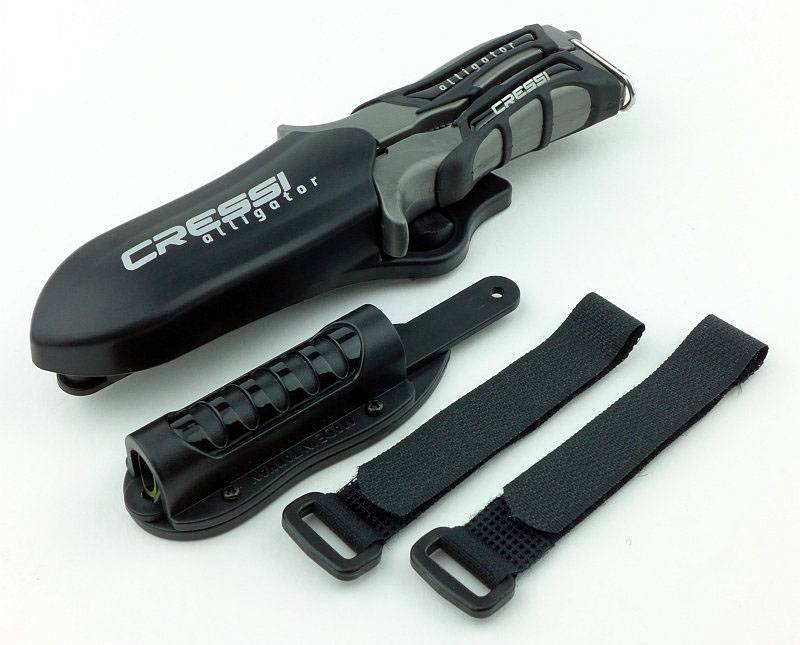
The mounting kit includes a hose mount with hose shim (for smaller hoses) plus a straight bar for fitting around webbing.
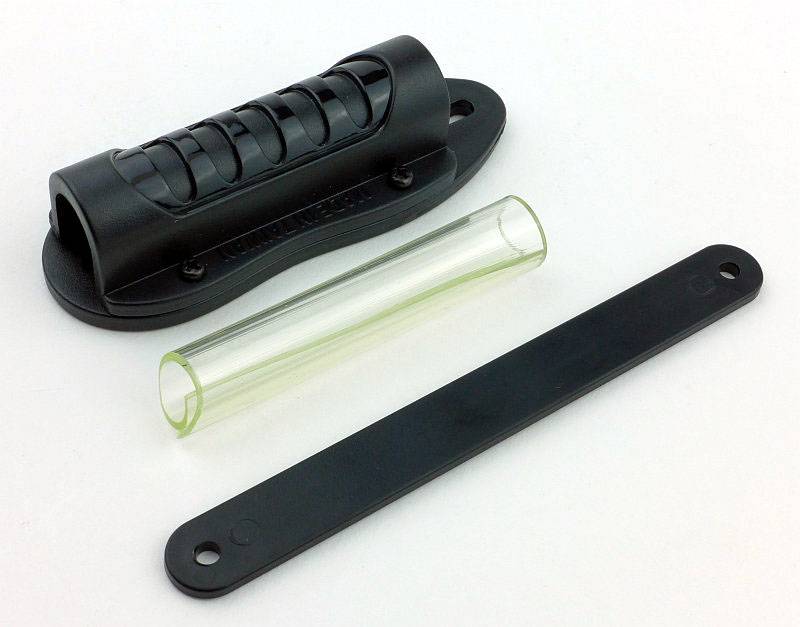
In the moulded plastic sheath is a sprung knife-retaining plate which clicks into place on the knife handle to hold it in place.
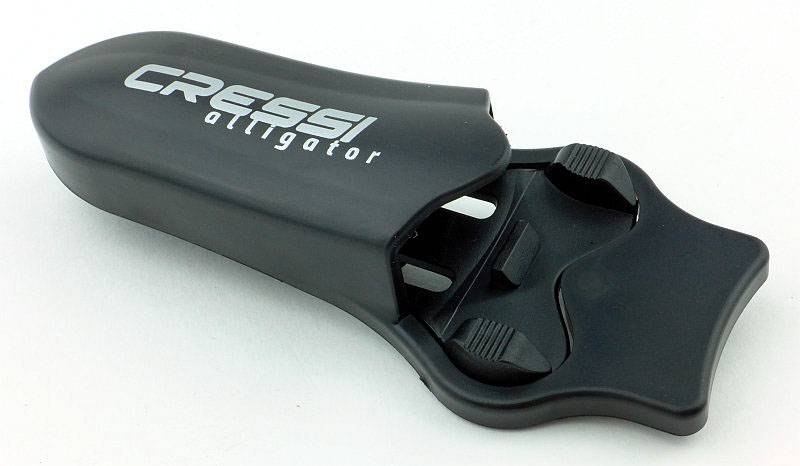
On the back of the sheath are the screw points for attaching the various mount options.
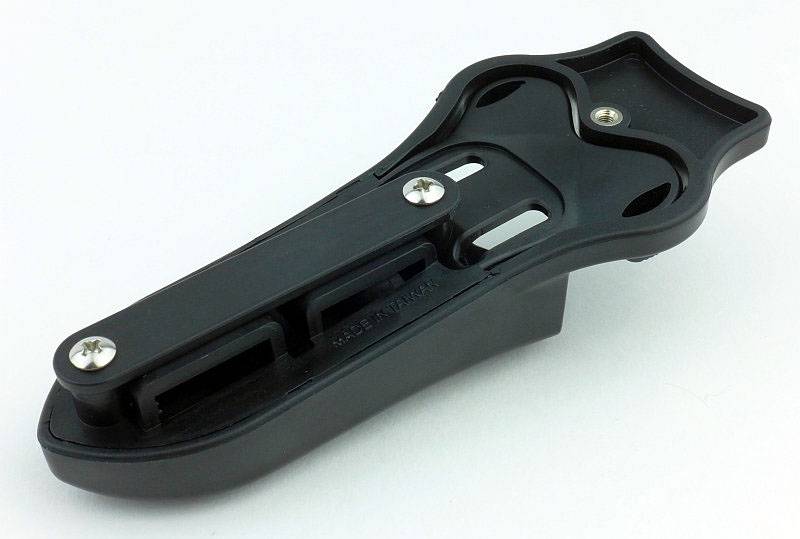
Is it a knife? Is it a pair of shears? Actually it is both.
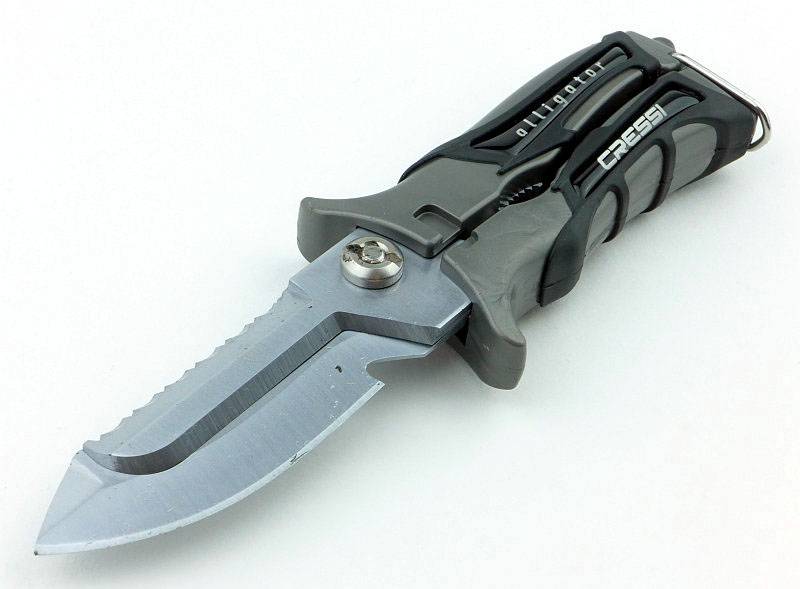
Viewed from the other side it looks a bit more knife like.
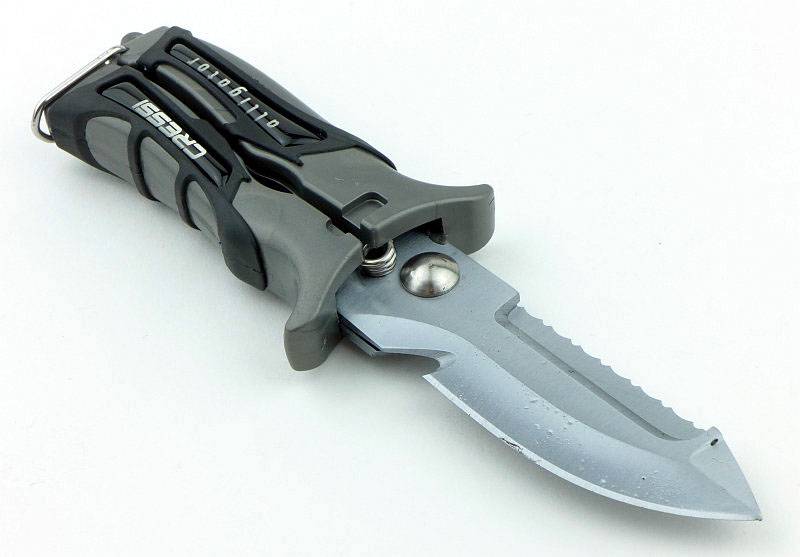
At the base of the handle is a metal loop which holds the two parts of the handle together.
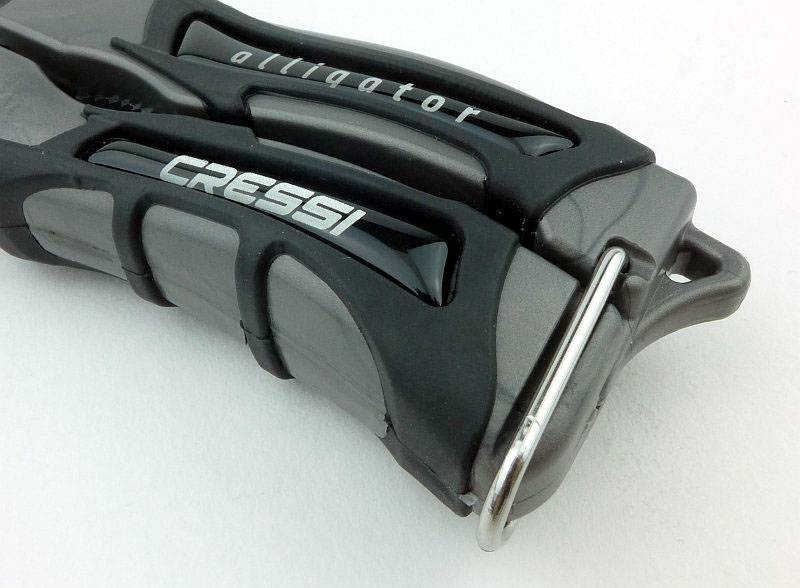
Flipping the clip outwards frees the handle to open up.
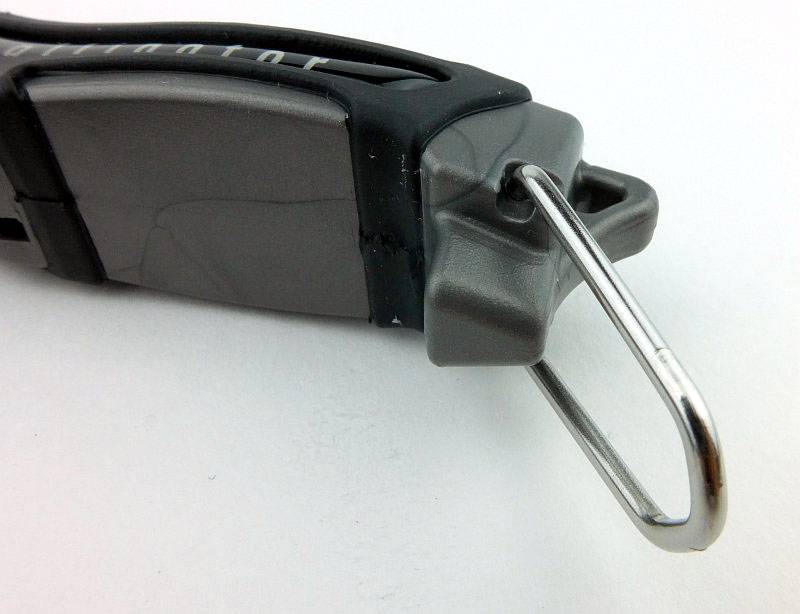
As you might expect with smaller shears the pivot is sprung loaded to make them easy to use.
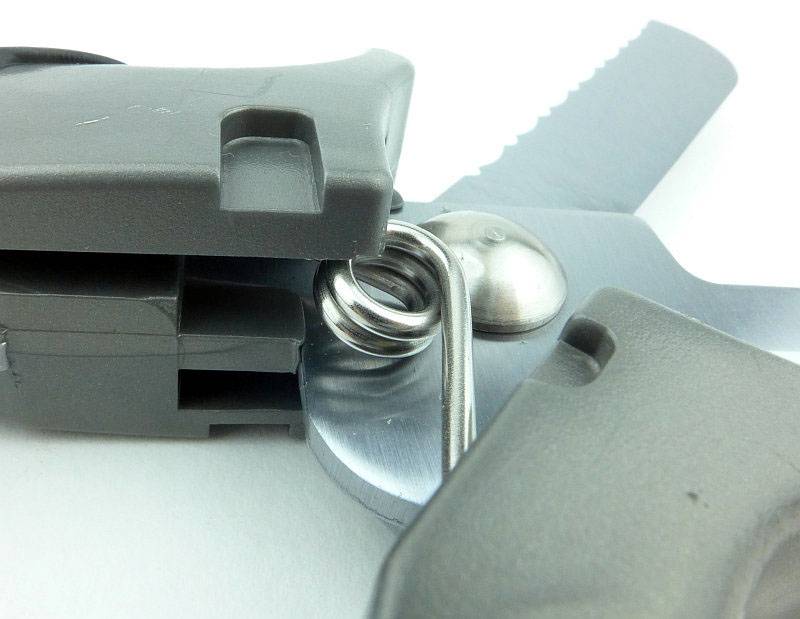
Inside the handles is a set of gripping teeth that can be used to grip and twist nuts/bolts and other objects you need more grip for.
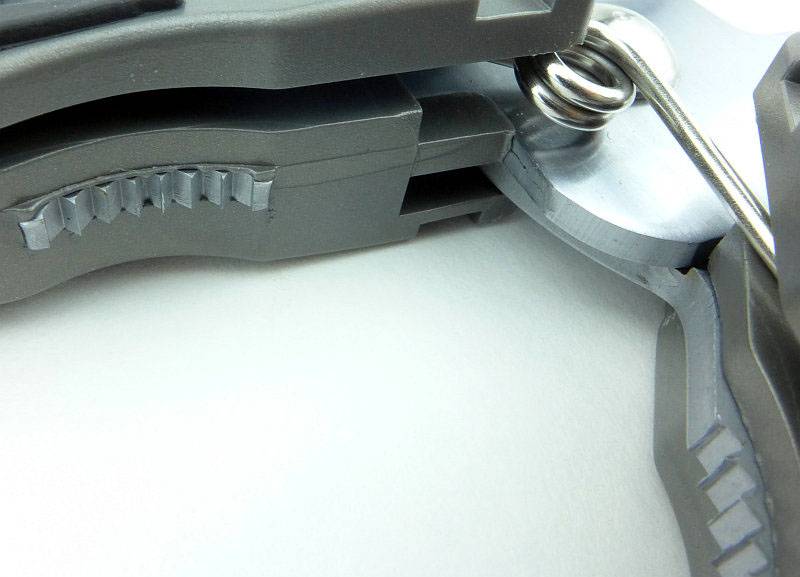
And there we have them, the Alligator’s jaws. Anyone having to cut loose lines underwater will know just how effective shears are for this task.
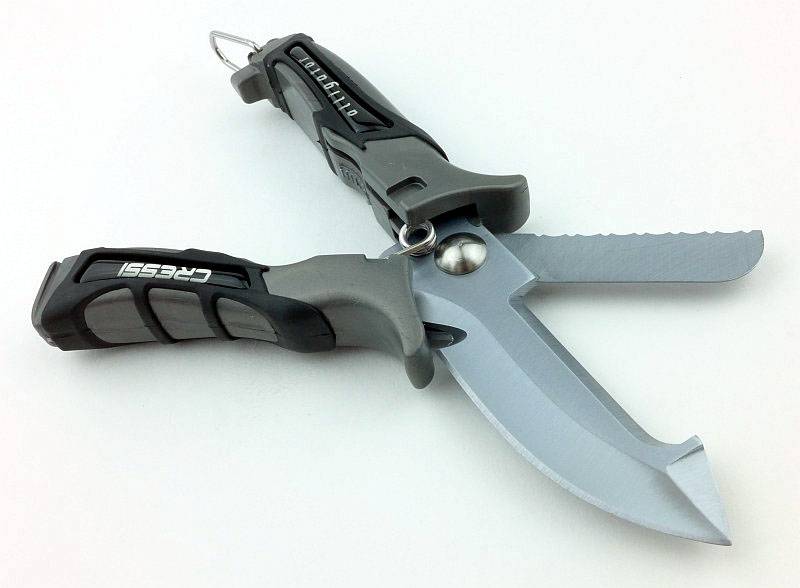
Also included is a line cutting hook.
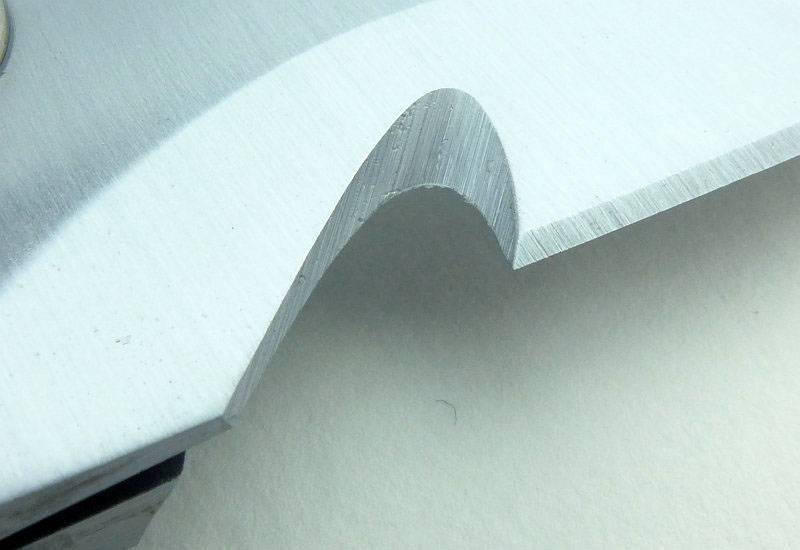
A close view of the knife point. Though not a needle sharp point, I prefer the tip not to be too sharp for a diving knife.
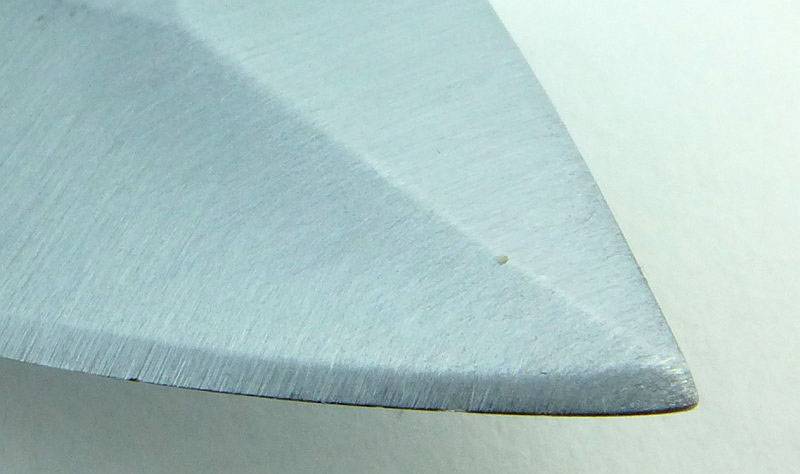
The spine of the ‘knife’ (the top jaw of the shears) has serrations cut into it.
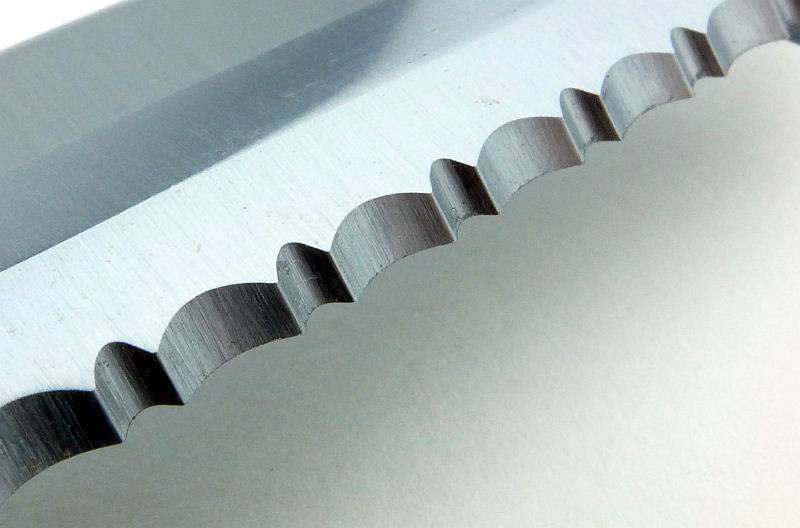
The serrations are formed from a single bevel.
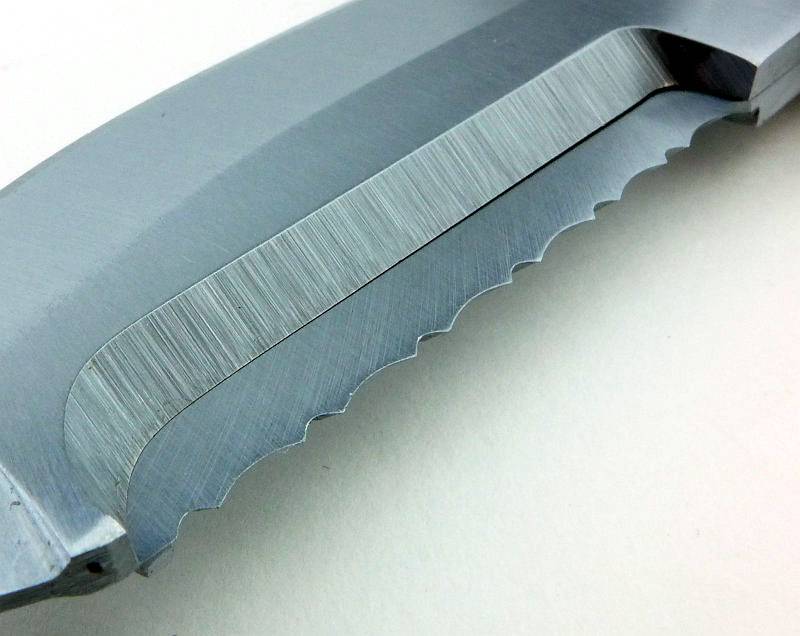
Looking at the top jaw of the shears, the grind is very clean and precise.
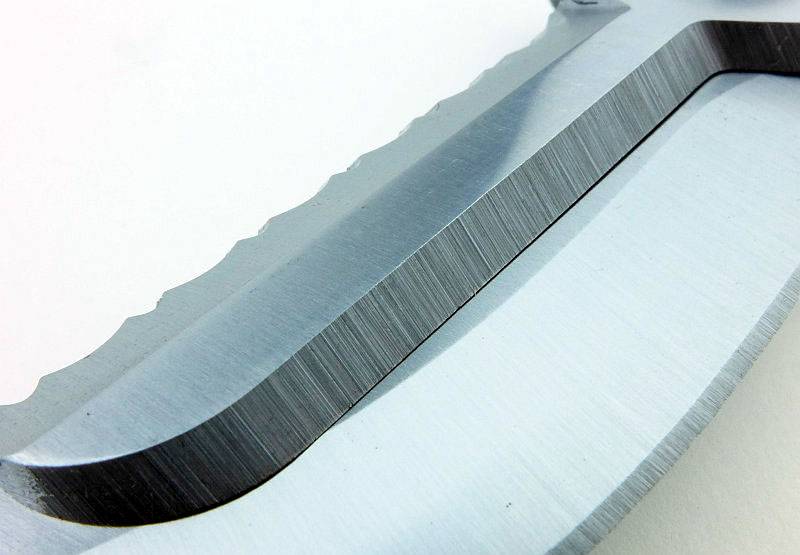
One side of the pivot bolt has a security type nut. To tighten this you need a flat head screwdriver with the middle ground out. On trying to adjust this it appears that either thread-lock or some other method has been used to hold this nut in place, so I’ll be leaving it until it needs adjustment.
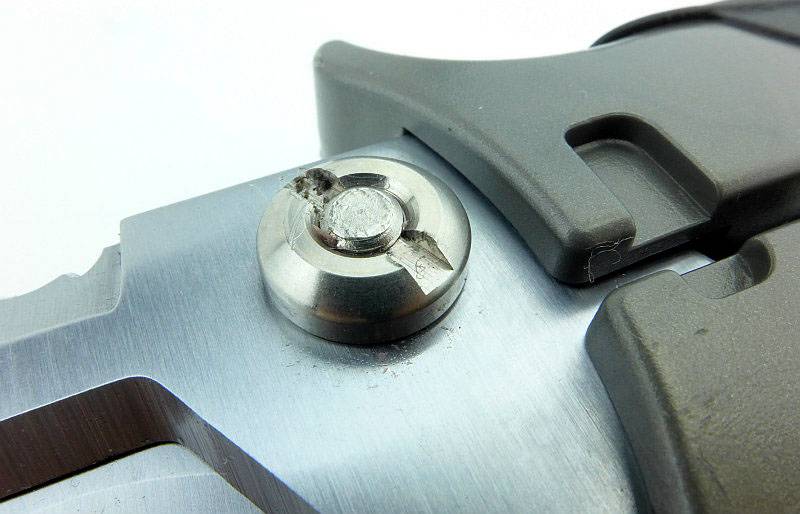
You can sheath the Alligator either way round, however one way is easier than the other.
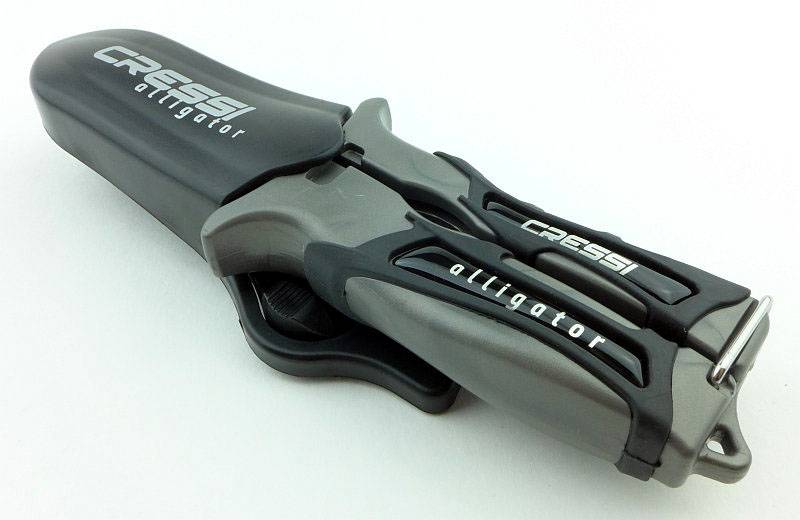
The reason it is easier to sheath the knife one way round is due to the blade being offset.
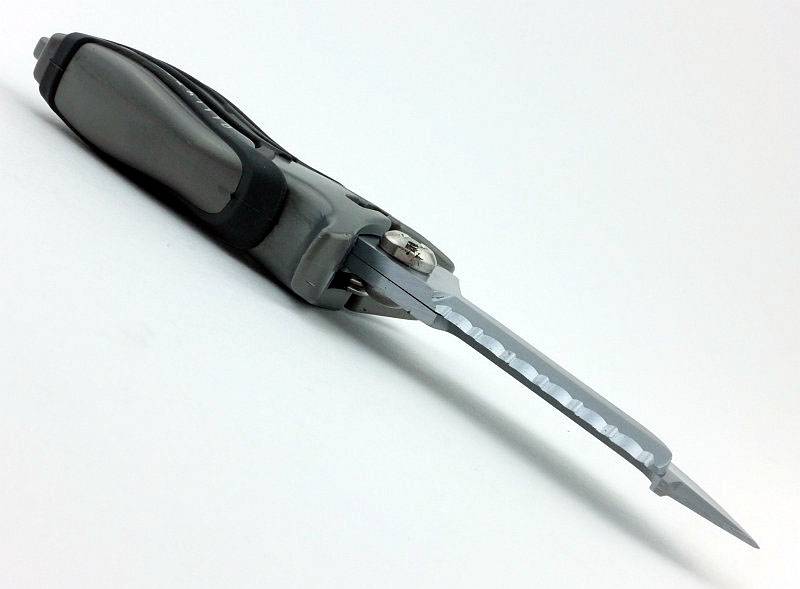
Looking closer you can see that the offset allows the spring for the shears to be incorporated. You can also see the plastic scrapings on the pivot nut where it has rubbed on the sheath.
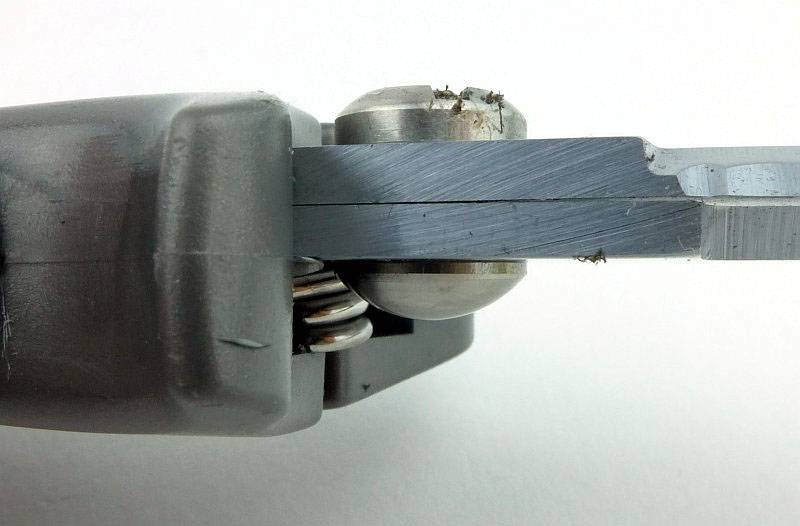
Feature packed and very versatile.
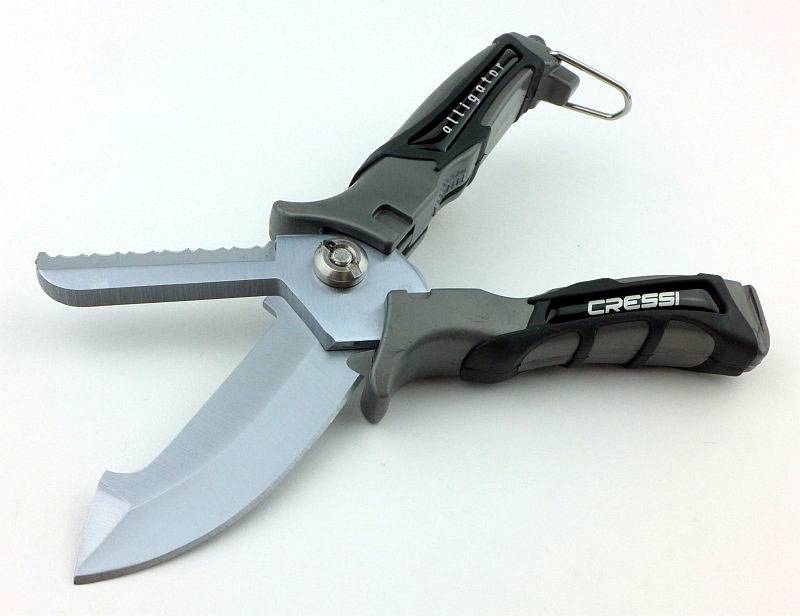
What are they like to use?
There are those that say there is no need for a big diving knife any more. For many this may be true, and they are better served by something smaller, or even just a line cutter, but there is still a place for the BFK when you need a tool that can take on bigger tasks. Cressi recognise this and that is why they have recently introduced the Giant Knife.
This review includes a cutting tool from both ends of the size spectrum with the much more compact Alligator which is a pair of shears as well as a knife. The Alligator is supremely effective for cutting and in the cutting tests has been scored separately as both a knife and as shears. The cutting score for the shears was joint first place, and the knife was not a bad performer at all. If you combined both scores, it is head and shoulders above any other knife in the Mega Test. The Giant Knife was a respectable performer, but the cutting hook and serrations were poor. See the Dive Knives 2016 – Mega Test Review for more information on the cutting test results.
For stainless steel tools, both Cressi knives came out of the corrosion test very well. There is a small amount of rust showing near the pivot between the two halves of the shears.
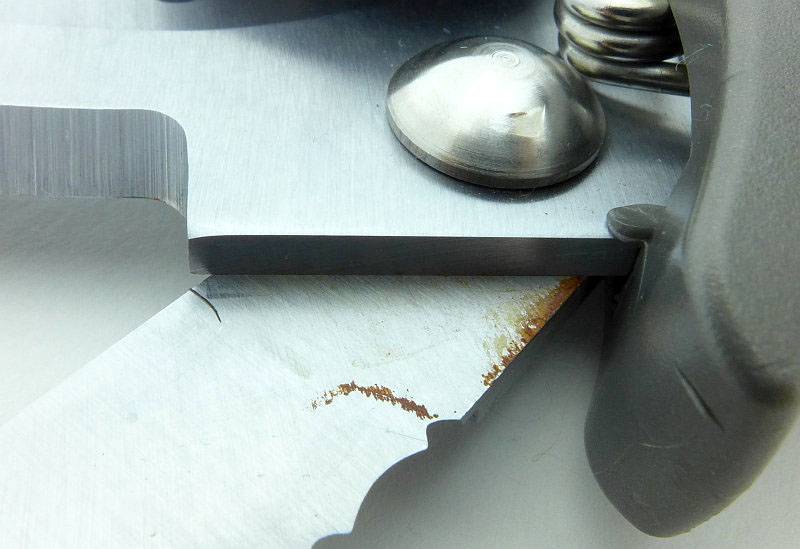
There is also some rust on the gripping jaws inside the handles.
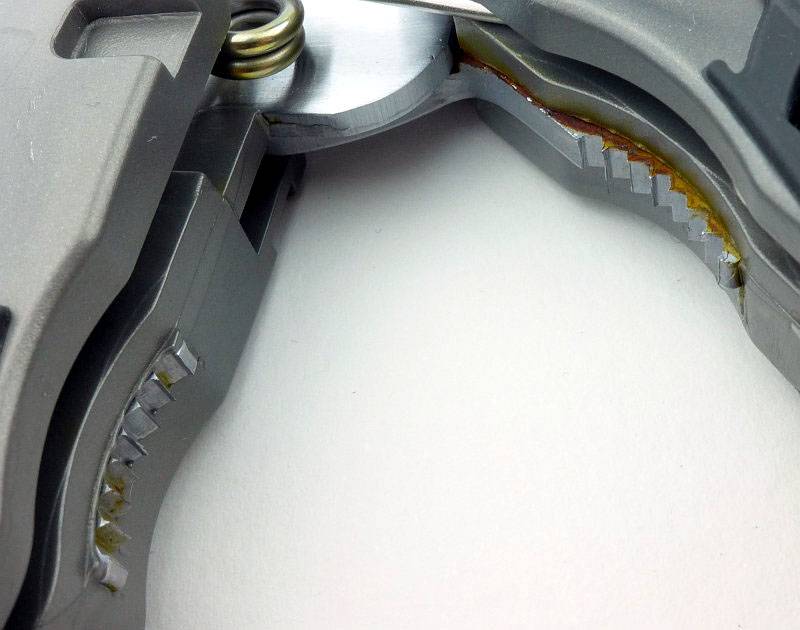
For the Giant Knife, there is nothing to show for the corrosion testing as there was no visible rust to be found on the knife.
Going back to the Giant Knife… Oh yes, this is a BFK! If you want a decent sized diving knife then the Giant Knife is a very good fit. It is big, the blade is thick, it is heavier than most, but you have a heavy duty tool you can really put to work. The shaped rubber handle gives you a very positive grip and lets you go for it. With some weight behind it, the hammer pommel is effective (just watch where that point is going).
(For size reference, I wear XL size gloves).
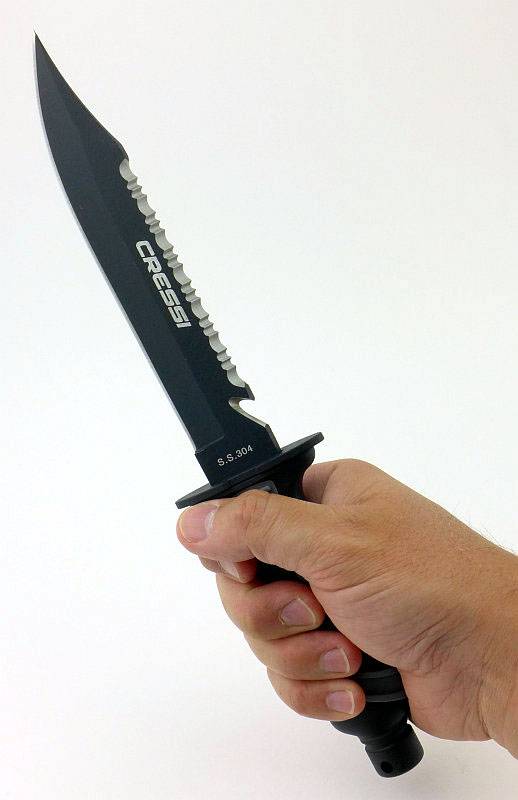
Going the other way now, and as the Alligator is much more compact than the Giant Knife, the grip is nearly (but not quite) too short. Despite the smaller size, the Alligator’s knife is effective in all its aspects, with the cutting hook working well and serrations working reasonably.
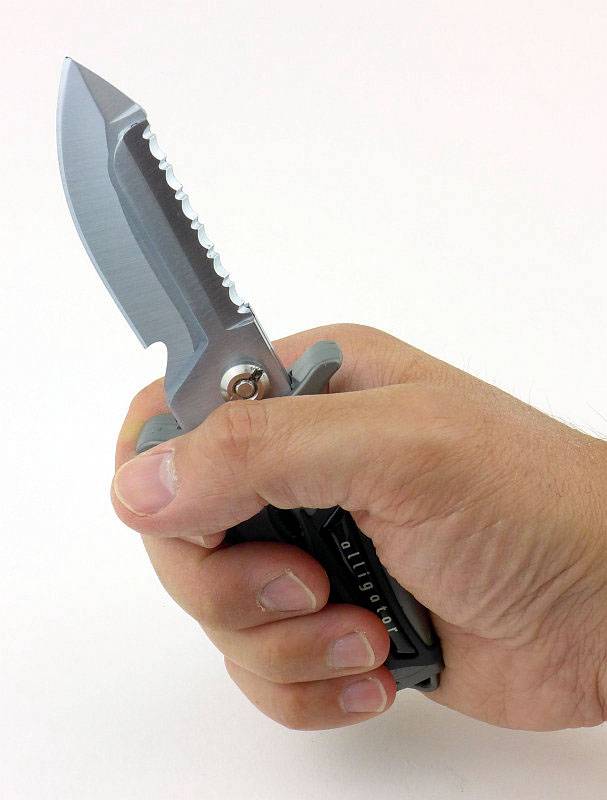
But the jewel in the Alligator’s crown are the shears. Wet lines and rope can be very difficult to grip and cut with a knife. Free-floating lines even worse, but shears grip the line for you, making it so much easier to cut. Notice how the tip of the shears in the knife blade is hook shaped, which prevents lines slipping out of the front of the jaws. Being spring loaded makes the shears stay firmly in the hand as you use them. Even without the knife blade elements of the Alligator, it would be worth having just for these shears.
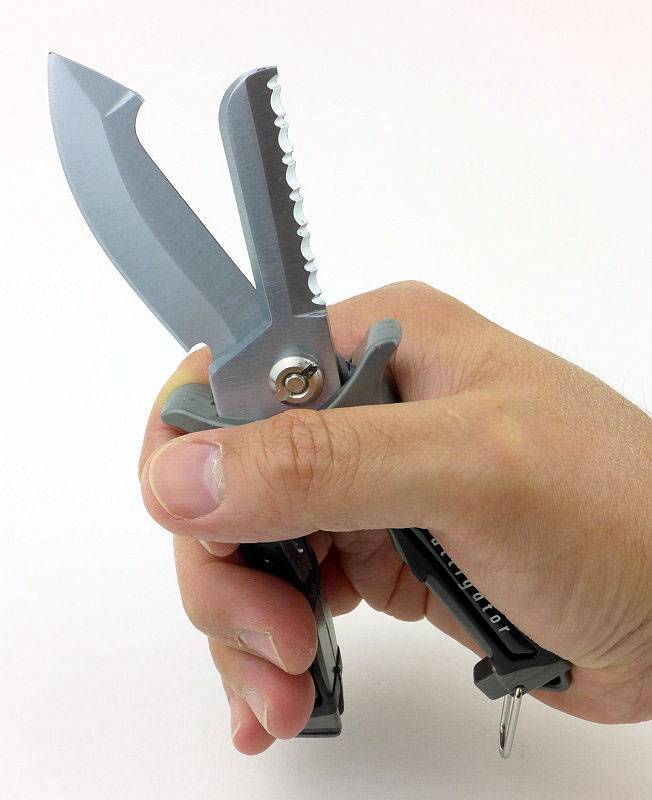
Review Summary
The views expressed in this summary table are from the point of view of the reviewer’s personal use. I am not a member of the armed forces and cannot comment on its use beyond a cutting tool or field/hunting knife.
Something that might be a ‘pro’ for one user can be a ‘con’ for another, so the comments are categorised based on my requirements. You should consider all points and if they could be beneficial to you.
| _______________________________________________ | _______________________________________________ |
| Things I like | What doesn’t work so well for me |
| _______________________________________________ | _______________________________________________ |
| The Alligator gives you the cutting power of shears as well as a knife blade. | Neither design is safe for ‘release’ cutting next to the body. |
| The Giant gives you a true heavy duty ‘BFK’ for diving. | The Giant Knife’s serrations and hook are ground at far too wide an angle to be effective. |
| Extremely good corrosion resistance. | The Alligator handle catch can be tricky to open, especially with gloves on. |
| Both ends of the size spectrum are represented. | |
| Sheaths work right or left handed. |
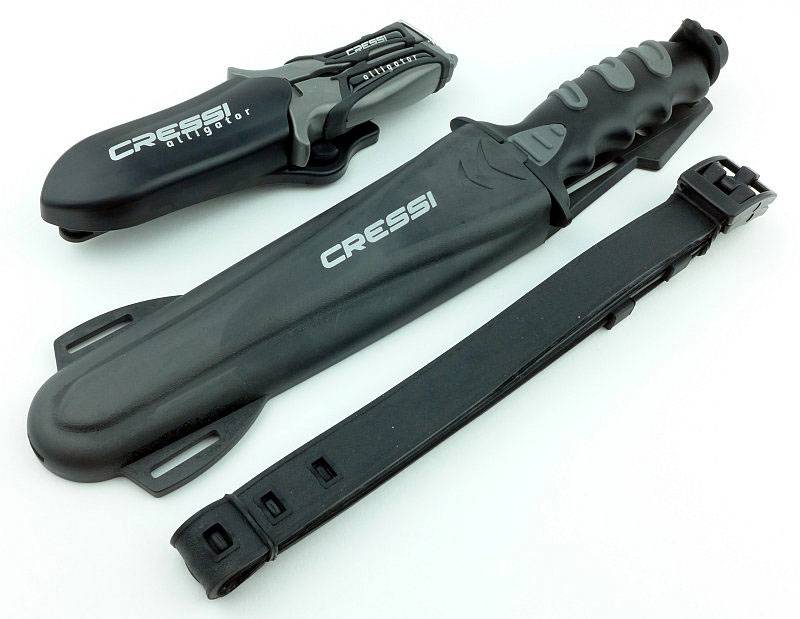
Discussing the Review:
Please feel free to add comments to the review, but the ideal place to freely discuss these reviews is on a forum. If you started reading the shorter forum version of the review, but followed the link this full exclusive review, please return to that forum to discuss the review there.
If you read the review entirely on Tactical Reviews, please consider one of the following to join in any discussion.
EdgeMatters – Sponsored Reviews (UK based Forum for Knife Makers and Collectors)
BladeForums – Knife Reviews (US based Forum for Knife Discussion)
CandlePowerForums – Knife Reviews Section (Largest and Friendliest Flashlight Community Forum)

